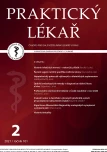History of infections – never ending story
Authors:
V. Bencko 1; P. Šíma 2; L. Vannucci 2
Authors‘ workplace:
Ústav hygieny a epidemiologie 1. LF UK a VFN, Praha , Přednosta: prof. MUDr. Milan Tuček, CSc.
1; Laboratoř imunoterapie, Mikrobiologický ústav, v. v. i., AV ČR, Praha, Ředitel: Ing. Jiří Hašek, CSc.
2
Published in:
Prakt. Lék. 2021; 101(2): 67-73
Category:
Editorial
Overview
The optimistic dream of a "Golden Age without infections" remained a dream. To this day, as in the past, epidemics, or worse pandemics, caused by different infectious agents still emerge in various parts of the world. Reports of infectious diseases such as measles, tuberculosis, HIV, syphilis, cholera, and a persistently high incidence of malaria, including other transmissible diseases, continue to occur periodically, often accompanied by an increase in the number of affected people. Moreover, new infectious diseases are emerging, which of pathogens have not yet been reliably identified or are already known, but up to this time have been considered non-pathogenic to humans. However, the current pandemic of Covid-19 (Coronavirus disease) caused by the new coronavirus SARS-CoV-2 (Coronaviridae) has proved to redirect biomedical research mainly to early diagnosis and rational therapy of respiratory viruses in particular, as well as to preventing their spreading not only by conventional means (limitation of direct contacts among persons, protection by masks, or by hand hygiene), but also by supporting of antiviral non-specific immunity. However, ensuring the rapid development of safe and effective vaccines is essential, by means of using the latest knowledge of contemporary biomedicine including that of molecular-genomic technologies (sequencing the genome of the SARS-CoV-2) with the hope that the newly constructed vaccines will be equally effective against genetic variants of the virus elicited by its expected mutations.
Keywords:
infectious diseases – epidemy – pandemic – eradication – anthropo-zoonoses – focus of infection – infections spread – Population growth – migration – intercontinental transport
Sources
- Stewart WH. Symposium on circumpolar health related problems, July 23–28, 1967. Opening remarks. Arch Environ Health 1968; 17(4): 460–461.
- Mahler H. Worldwide smallpox eradication: 1977. Nord Med 1977; 92(10): 236–240.
- Fenner F, Henderson DA, Arita I, et al. Smallpox and its eradication. Geneva: World Health Organization 1988.
- Boylston AW. Defying Providence. Smallpox and the forgotten 18th century medical revolution. Charleston, SC: CreateSpace 2012.
- WHO. Archives of the smallpox eradication programme, a guide and inventory. Geneva: WHO 1982, 2 vol.
- Black FL. Infectious diseases in primitive societies. Science 1975; 187(4176): 515–518.
- Sakula A. Robert Koch: Centenary of the Discovery of theTubercle Bacillus [online]. Dostupné z: https://www.ncbi.nlm.nih.gov/pmc/articles/PMC1790283/pdf/canvetj00269-0053.pdf [cit. 2021-02-12].
- Riedel S. Anthrax: a continuing concern in the era of bioterorism. Proc (Bayl Univ Med Cent) 2005; 18(3): 234–243.
- Koch R. Die Ätiologie der Milzbrandkrankheit, begründet auf die Entwicklungsgeschichte des Bacillus Anthracis. Beiträge zur Biologie der Pflanzen 1876; (2): 277–310.
- CDC. History of Anthrax [online]. Dostupné z: https://www.cdc.gov/anthrax/resources/history/index.html [cit. 2021-02-12].
- Budianski S. The covenant of the wild: why animals chose domestication. London: Phoenix 1997.
- Karamanou M, Panayiotakopoulos G, Tsoucalas G, et al. From miasmas to germs: a historical approach to theories of infectious disease transmission. Infez Med 2012; 20(1): 58–62.
- Wikipedia. Miasma theory [online]. Dostupné z: http://broughttolife.sciencemuseum.org.uk [cit. 2021-02-12].
- Infectious diseases at the Edward Worth library. Theory of Contagion [online]. Dostupné z: http://infectiousdiseases.edwardworthlibrary.ie/theory-of-contagion/ [cit. 2021-02-12].
- Oldstone MBA. Viruses, plagues and history: past present and future. New York: Oxford University Press 2020.
- Gibbon E. Úpadek a pád římské říše: výbor. 1. vydání. Praha: Odeon 1983.
- Karlen A. Plague’s progress: a social history of man and disease. London: Indigo 1995.
- Malthus TR. Esej o principu populace. Brno: „Zvláštní vydání“ 2003.
- Warren JR, Marshall B. Unidentified curved bacilli on gastric epithelium in active chronic gastritis. Lancet 1983; 1(8336): 1273–1275.
- WHO. World Health Data Platform [online]. Dostupné z: https://www.who.int/data [cit. 2021-02-12].
- White Franco-Paredes C. Leprosy in the 21st century. Clin Microbiol Rev 2015; 28(1): 80–94.
- Almeida DJ, Tyrrell DAJ. The morphology of three previously uncharacterized human respiratory viruses that grow in organ culture. J Gen Virol 1967; 1(2): 175–178.
- Šíma P. Infekční nemoci nekončí. Vesmír 2003; 82 : 443–445.
- Coronaviridae Study Group of the International Committee on Taxonomy of Viruses, Gorbalenya AE, Baker SC, et al. The species Severe acute respiratory syndrome-related coronavirus: classifying 2019-nCoV and naming it SARS-CoV-2“. Nat Microbiol 2020; 5(4): 536–544.
- Odkazy na SZO: https://www.who.int/data
Labels
General practitioner for children and adolescents General practitioner for adultsArticle was published in
General Practitioner

2021 Issue 2
- Metamizole vs. Tramadol in Postoperative Analgesia
- Memantine in Dementia Therapy – Current Findings and Possible Future Applications
- Metamizole at a Glance and in Practice – Effective Non-Opioid Analgesic for All Ages
- What Effect Can Be Expected from Limosilactobacillus reuteri in Mucositis and Peri-Implantitis?
- Metamizole in perioperative treatment in children under 14 years – results of a questionnaire survey from practice
Most read in this issue
- A vegan patient: nutritional characteristic of plant-based diet
- History of infections – never ending story
- Hepatotoxic potential of nutritional and dietary supplements
- Knowledge of nurses of disinfection of selected objects and surfaces in the provision of health services
